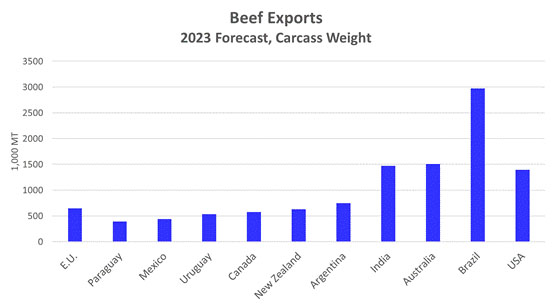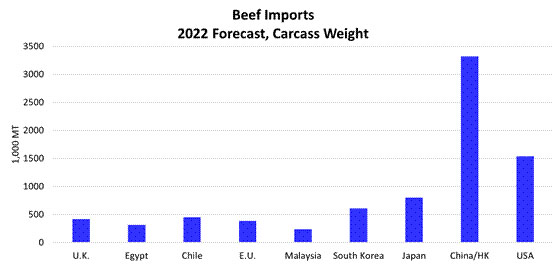Cow-Calf Corner | December 12, 2022
Major Beef Exporters and Importers in 2023
Derrell S. Peel, Oklahoma State University Extension Livestock Marketing Specialist
Global beef production is forecast to decrease slightly in 2023. Beef production decreases in the U.S. and European Union will more than offset increasing beef production in Australia and modest increases in Mexico and India. Changes in beef production and consumption will impact global beef exports and imports in the coming year.
Brazil is expected to remain the largest beef exporter with beef production increasing slightly in 2023. Brazil beef exports are limited by decreased beef imports in China. Beef exports from Brazil are significantly higher than the next three exporters. Australia, after drought in recent years decreased cattle numbers and beef production, is now in rebuilding mode. Cattle prices are falling from historically high levels in Australia and beef exports are forecast to increase, helping Australia regain the number two spot. The U.S., number two beef exporting country in 2022 with record or near-record exports, will likely see exports decrease with declining beef production, higher beef prices and a continued strong dollar. The U.S. will likely drop to fourth place, a position it has frequently occupied in recent year. India is the remaining top four beef exporter with steady exports expected in 2023. India exports large quantities of water buffalo meat (carabeef) to low-end markets in Indonesia and Malaysia.
Source: USDA-FAS, October 2022
China/Hong Kong is the largest beef importing country in the world since 2018 and will be the largest by a factor of two in 2023. Prior to the rapid growth in China/HK imports in recent years, the U.S was the largest beef importing country for many years. Beef imports in China/KH may decrease in 2023 for the first time ever as the country struggles with a recession and continued zero-Covid controls. The U.S. may see beef imports increase modestly as beef production falls and supplies of processing beef drop sharply. Rising U.S. beef prices and the strong dollar will further attract beef into the U.S. from other markets. The number three and four beef import markets, Japan and South Korea, are expected to see minor increases in beef imports in 2023.
Source: USDA-FAS, October 2022
Forage Budgeting with Non-Traditional Sources of Hay
Mark Z. Johnson, Oklahoma State University Extension Beef Cattle Breeding Specialist
Determining how much forage cows will eat on a per day and per month basis for the duration of winter always requires a little “cowboy math”. Chapter 16 of the eighth edition of the OSU Beef Cattle Manual is an excellent reference for estimating intake and the nutritional requirements of dry and lactating beef cows. This year, with many “non-traditional” sources of hay such as soybean, milo, cotton and corn fields that were turned into hay out of dire necessity, requires a little additional math to make a good estimate. Making the best estimation of how much hay you will need over the next few months still requires a feed analysis test. The information gained through an analysis, like TDN (energy content) and Crude Protein serve as a guide of two things: 1) how much cows will consume, and 2) how much they will need of a specific hay (or feed supplement) to meet their nutritional requirements.
For example, a 1300 pound, dry cow in the last trimester of pregnancy requires 13.3 pounds of TDN and 1.84 pounds of energy per day. A hay testing with 54% TDN and 7.5% Crude protein consumed at 1.9% of her body weight results in a daily dry matter intake of 24.5 pounds of dry matter. This intake of this hay will meet her daily needs without additional supplementation.
If we consider how much actual hay we need to provide each day a few more items need to be taken into consideration:
- Hay isn’t all dry matter. Assuming our hay is 90 – 93% dry matter (or 7-10% water). Taking this into account adds another 2-3 pounds of hay per day “as fed”.
- Hay will be wasted. Depending on quality of the hay, weather, type of hay feeder used or feeding method, cows will waste 6 – 20% of each bale fed. If you are feeding a non-traditional hay there may be more sorting by cows. Specifically, the bottom end of the corn or sorghum stalk is very low in nutrient quality, cows will sort out most of this portion and intake will be very low. In the past few weeks, I am hearing estimates from producers feeding cornstalk hay that up to 30-40% of the bale is stalks which cows will not eat. This needs to be taken into consideration. Assuming 20% of each bale is wasted, it adds another 7-8 pounds of hay per day “as fed”. After taking dry matter content and waste into account we are looking at 34-35 pounds of hay per day needed.
- What else should you consider? What does each bale weigh and how much is spoiled? If you have purchased hay by tonnage, it is easy to calculate the average weight of each bale. Rule of Thumb for estimating how much spoilage per bale: approximately 1/3 of the bale weight of a 5 ½ foot diameter round bale is in the outer 6 inches. Even 2-3 inches of spoilage on the bottom side of the bale can equal a substantial loss.
Hay is highly valuable and in short supply. Use these guidelines to estimate at how much you need to be providing per cow per day and extend it over the winter to decide how much hay inventory is enough.
One final point, feeding waste can be reduced! Open bottom round bale feeders can have up to 30% waste, sheeted bottom feeders can reduce this to 20%. Cone feeders can reduce the waste to less than 10%.
References: Chapter 16, page 131. Eight Edition OSU Beef Cattle Manual
Dr. Mark Johnson discusses proper hay storage on SunUpTV’s Cow-Calf Corner.
The Value of Vitamin A
Barry Whitworth, DVM, OSU Eastern Oklahoma Area Food/Animal Quality and Health Specialist
According to Dr. Greg Hanzlicek, with the Kansas State Veterinary Diagnostic Laboratory (KSVDL), Kansas had an unusually high number of stillbirth cases and weak born calves in the spring of 2019. After many laboratory tests, it was concluded that the problem stemmed from a lack of energy, protein, Vitamin A, or combinations of all of these.
Research has shown that low vitamin A levels during pregnancy are associated with abortions, stillbirths, and weak born calves. In addition to playing an important role in reproductive efficiency, vitamin A is essential for vision, bone growth, and maintaining epithelial tissue such as skin and hooves.
Animals obtain vitamin A from consuming green forage and/or the addition of vitamin A supplements to the diet. Lush green pastures contain high amounts of vitamin A. As plants mature and during times of drought, the amount of vitamin A decreases. In general, animals obtain adequate amounts of vitamin A by grazing green forage. Animals grazing green pastures will build a healthy store of vitamin A in the liver. When vitamin A is in short supply, the stores in the liver prevent deficiencies. According to Dr. Lalman, Extension Beef Cattle Specialist Oklahoma State University, the stores should last 2 to 4 months during times of deficiency.
Preventing vitamin A deficiency depends on producers being attentive to the environmental conditions that favor low vitamin A levels in forage. During these times, producers need to supplement the diet with vitamin A. Producers need to be aware that Vitamin A supplements degrade rapidly, so vitamin A supplements should not be stored for long periods of time. In addition to vitamin A supplementation, research indicates that diets low in protein result in poor absorption of vitamin A. It is important that producers ensure that the rations have sufficient protein levels. Lastly, since colostrum contains high levels of vitamin A, producers need to ensure that newborns obtain adequate amounts of colostrum at birth.
Most of Oklahoma had below average rainfall for the year of 2022. This resulted in pasture quality decreasing earlier than normal. Due to this year’s lack of green forage, liver stores of vitamin A may be inadequate for the animal’s needs. Producers need to ensure that the diets of their cattle have adequate amounts of vitamin A, energy, and protein.


